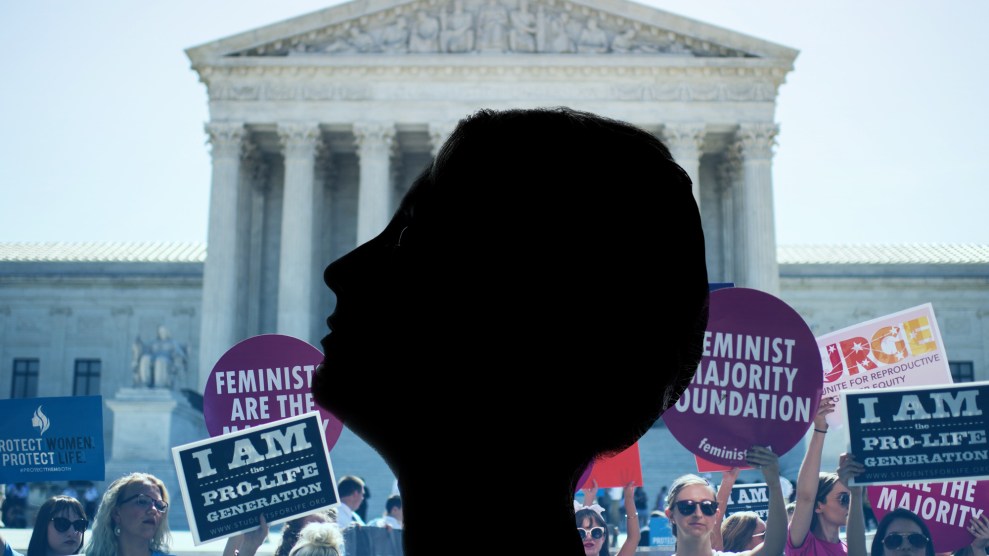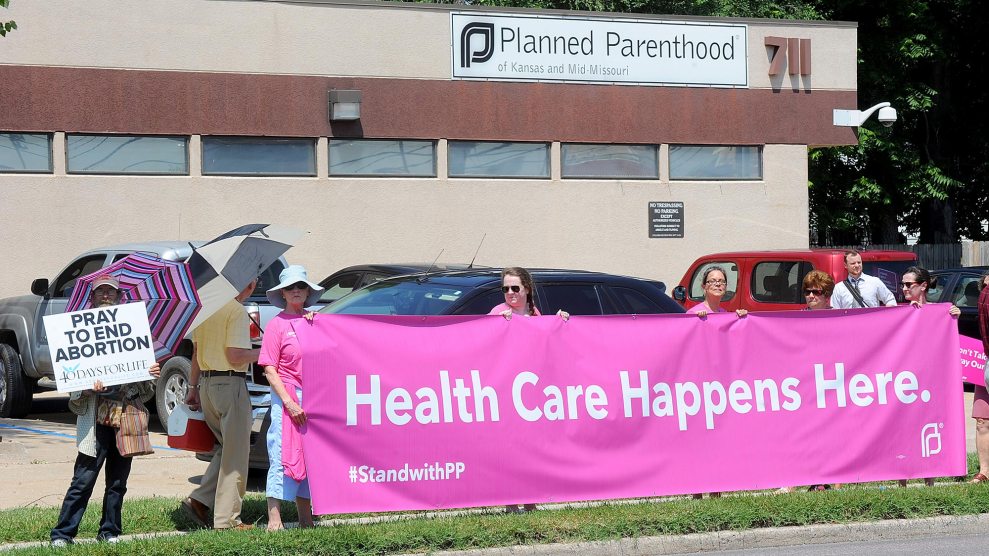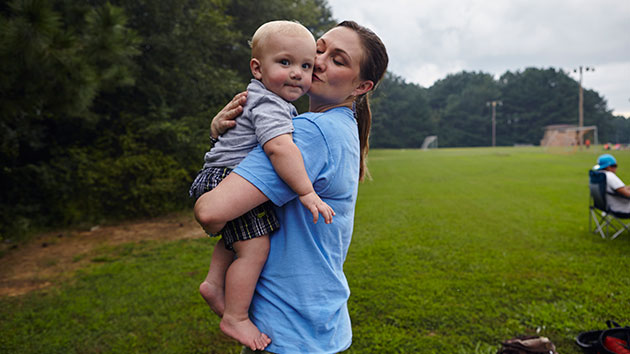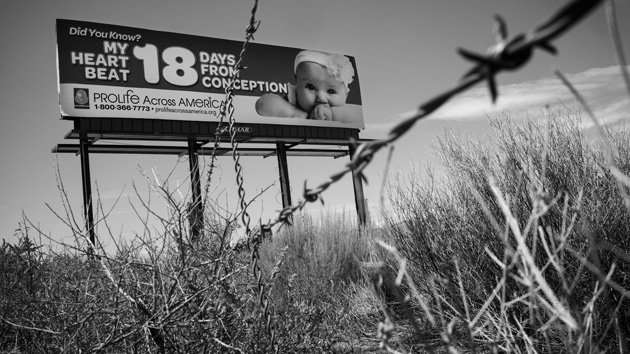
Congressional Quarterly/Newscom/Zuma; <a href="http://www.shutterstock.com/gallery-1174673p1.html" target="_blank">Fantom_rd</a>/Shutterstock
Back in January, as the Supreme Court was preparing for its most important abortion case in a generation, some four dozen social scientists submitted a brief explaining why they believed key portions of Texas law HB 2 should be struck down. The brief was a 58-page compendium of research on everything from the relative dangers of abortion versus childbirth to the correlation between abortion barriers and postpartum depression. “In this politically challenged area, it is particularly important that assertions about health and safety are evaluated using reliable scientific evidence,” the researchers declared.
Six months later, the material they submitted clearly helped shape Justice Stephen Breyer’s majority opinion in Whole Women’s Health v Hellerstedt, which found critical elements of HB 2 unconstitutional. This decision also handed a resounding though less noticed victory to private donors who’ve spent more than a decade quietly pouring at least $200 million dollars into the scientists’ work, creating an influential abortion-research complex that has left abortion opponents in the dust.
The research initiative dates back at least to the early 2000s and became more urgent after the high court held in 2007 that in cases of “medical and scientific uncertainty,” legislatures could have “wide discretion” to pass laws restricting abortion. Since then, a primary objective of abortion rights supporters has been to establish a high level of medical certainty—both about the safety of the procedure and about what happens when a woman’s reproductive options are drastically curtailed or eliminated.
There’s little or no publicly funded research on this controversial subject in the United States, so for years basic information was lacking—from how often patients have complications to what happens to women who want abortions but can’t obtain them.
Into this breach stepped the Susan Thompson Buffett Foundation, named for the late wife of one of the richest men in the world. Established in the 1960s, the philanthropic behemoth (which ranked fourth among family foundations in 2014 in terms of giving) is known for its focus on abortion access, training, and, more recently, prevention. It’s also known for its secrecy, often appearing under grant acknowledgements only as “an anonymous donor.”
The Buffett Foundation helped finance the development of the abortion drug RU-486 back in the 1990s. From 2001 to 2014, it contributed more than $1.5 billion to abortion causes—including at least $427 million to Planned Parenthood worldwide, $168 million to the National Abortion Federation—a track record that led one abortion foe to call Warren Buffett the “sugar daddy of the entire pro-abortion movement.” In the past 15 years, it has also made research a core part of its strategic efforts, funding such organizations as the Guttmacher Institute, a policy think tank and advocacy group that tracks demographic and legislative trends ($40 million), and Gynuity Health Projects, which focuses on medication abortion ($29 million) and work by academics abroad. Other foundations supporting research on a smaller scale have included the William and Flora Hewlett Foundation, the David and Lucile Packard Foundation, the John Merck Fund, and the Educational Foundation of America. (Hewlett is also a funder of ProPublica.)
Buffett’s main academic partner (receiving at least $88 million from 2001 to 2014) has been the University of California-San Francisco, a medical research institution with a strong reproductive health infrastructure. (Abortion opponents’ perspective is a bit different: “America’s abortion training academy,” one National Right to Life official recently called it). Historically, “it’s very unusual for foundations to fund research,” Tracy Weitz, former director of the UCSF’s Advancing New Standards in Reproductive Health project (ANSIRH, pronounced “answer’), told ProPublica in 2013. But over the last 10 or 12 years, “there’s been recognition in the philanthropic community that in order to make progress, either culturally or politically or in the service-delivery arena, there are research questions that we need to answer.”
Located in the state with the strongest record on reproductive rights, UCSF has been able to do pioneering studies without the kind of political interference that might be expected elsewhere. Indeed, California lawmakers have granted special protections for people who work in the reproductive health field, while state health agencies worked behind the scenes to facilitate a potentially controversial project that involved training non-doctors to perform abortions (see sidebar). The ANSIRH program was established in 2002 as part of UCSF’s Bixby Center for Global Reproductive Health and lists more than two dozen separate abortion-related initiatives on its website on everything from mandatory ultrasound-viewing laws to abortion in movies and TV to reproductive health access for women in the military. The funder and recipient have been closely intertwined; Weitz left UCSF to become the Buffett Foundation’s director of US programs in 2014.
Well before the Texas case, foundation-backed researchers had already begun to churn out studies aimed at debunking some of the most common justifications for new abortion restrictions: that clinics were teeming with incompetent and unscrupulous doctors; that injured, abandoned patients were flooding emergency rooms; that the psychological damage caused by grief and regret after abortions often persists for years and ruins women’s lives.
Over the past three years, their findings have influenced a string of policy changes—prompting the Food and Drug Administration to revise its labeling guidelines for abortion drugs, persuading the Iowa Supreme Court to uphold a telemedicine program for medication abortion, and convincing the California Legislature to allow health care professionals besides doctors to perform first-trimester abortions.
The proliferation of so-called Targeted Regulation of Abortion Provider laws, or TRAP laws, like HB2—which purport to protect women’s safety and health by imposing tough rules on clinics and doctors—provided the research effort with its greatest test, yet also an opportunity to put its findings to potent effect.
Buffett Foundation money underwrote the Texas Policy Evaluation Project, the small band of demographers, doctors, and public health specialists based at the University of Texas-Austin who came together in 2011, when lawmakers slashed family-planning funding, kicked Planned Parenthood out of the Medicaid women’s health program, and required sonograms 24 hours before an abortion. “We realized that this was going to have devastating impact on the reproductive health and safety network in the state,” said Daniel Grossman, an investigator for the project who also teaches at UCSF and replaced Weitz as ANSIRH’s director last year.
Then, in 2013, the legislature passed HB 2, an omnibus bill that required abortion clinics to upgrade their facilities to surgical-center standards, mandated doctors to have admitting privileges at local hospitals, imposed new restrictions on medication abortion, and banned abortion after 20 weeks. The TRAP provisions shuttered almost half of the state’s 41 clinics practically overnight, with stark consequences, the project found. The abortion rate dropped by 13 percent and medication abortions by 70 percent. Travel distances and costs soared and wait times sometimes stretched for weeks, leading to a 27 percent increase in more dangerous (and more expensive) second-trimester procedures. Some women considered self-inducing. Some unhappily carried their pregnancies to term. Meanwhile, part of HB 2 was on hold pending the Supreme Court ruling; if it went into effect, another 8 to 10 clinics would shut and the few clinics that remained would be inundated. “They didn’t really seem to have the capacity to increase their services,” Grossman said. “It was really concerning.”
The 5-to-3 majority ruling in Hellerstedt read like a 38-page recitation of the researchers’ findings, declaring the Texas laws served no real medical purpose and created an undue burden on women’s constitutional rights. Within days, TRAP laws also toppled in Mississippi, Wisconsin, and Alabama, and abortion rights groups announced plans to challenge other types of laws—for example, 72-hour waiting periods and bans on abortions after 20 weeks. “Abortion restrictions cannot rely on junk science,” said Stephanie Toti, an attorney with the Center for Reproductive Rights (which has received more than $20 million in Buffett funding since 2001). “There has to be credible scientific evidence to support the law, and there has to be a determination that the benefits of the law outweigh the harm.”
Some abortion opponents have been quick to argue that the research is not credible, in some cases because the people who do it are biased. Justice Samuel Alito insisted the Texas Policy Evaluation Project’s analysis of clinic closures and capacity was unconvincing. “Research is fine when it illuminates an issue,” Randall O’Bannon, education and research director for National Right to Life, told a reporter for his organization’s news site. But the findings were “crafted to protect the interests of the abortion industry with scant attention to the legitimate health and safety issues of Texas women, let alone unborn babies.”
The anti-abortion movement has recently attempted to launch its own research initiative. The Charlotte Lozier Institute was established in 2011 as a policy think tank alternative to Guttmacher. The American Association of Pro-Life Obstetricians and Gynecologists holds annual conferences at which researchers who oppose abortion discuss research they’ve done on links between abortion and breast cancer, depression, and drug abuse, in addition to holding workshops on how to serve as expert witnesses. But those operations are minuscule compared with those of Buffett and ANSIRH. “The pro-choice research seems to have almost unlimited funds,” Bowling Green State University’s Priscilla Coleman lamented at this winter’s AAPLOG conference. So far, researchers funded by abortion opponents lack the infrastructure to conduct the kind of data collection and analysis that academic institutions have done. “Picking the right groups to compare, following them for a long period of time, so that you can really see what the outcomes are— it’s long and it’s hard and it’s costly,” UCSF’s Rana Barar said.
Abortion opponents have often seen data and scientific evidence as almost beside the point, acknowledged Lozier’s president, Chuck Donovan. “For most people on the pro-life side of the debate, [abortion] is primarily an ethical, moral, for some a religious challenge.” As a result, “a statistical base, an analytical base [has gone] a little bit undernourished.” Individual researchers have been stymied by mainstream medical hostility, Steven Aden, senior counsel at the conservative legal powerhouse Alliance Defending Freedom, said this spring. “It is extraordinarily difficult to get even a solid study peer-reviewed and published.” And when it does happen, “because the politics are against them, they are subjected to a beat-down campaign, sometimes even when what they’re arguing is fairly straightforward.” Often the best those efforts could hope to achieve was to “generate uncertainty,” as Mary Ziegler, a law professor at Florida State University and author of After Roe: The Lost History of the Abortion Debate, put it. Before Hellerstedt, that was often seen as enough: “The idea [was] if there’s uncertainty, the tie-breaker goes to the lawmakers,” Ziegler said.
Even before the Texas decision, abortion foes had begun to shift away from women’s health and safety, instead expanding restrictions (such as longer mandatory waiting periods and tougher parental consent laws) and renewing the focus on protecting fetuses: “The science of fetal development is a burgeoning area,” Aden said.
Researchers funded by the Buffett Foundation and others, meanwhile, have mounted projects that look at the impact of abortion restrictions in Georgia, Utah, Ohio, and Tennessee.
“The role of research and the nature of relevant research will be different in different contexts,” CRR’s Toti said. “But what the court made clear is that abortion restrictions are going to be [evaluated] on an evidence-based standard. States can no longer rely on speculation about the potential benefits of [a] law.” The question now, she said, is “what actual benefit does a regulation provide and how does that compare with the extent of the burden the law is going to impose on women.”
ProPublica’s Sarah Smith contributed research help.
















